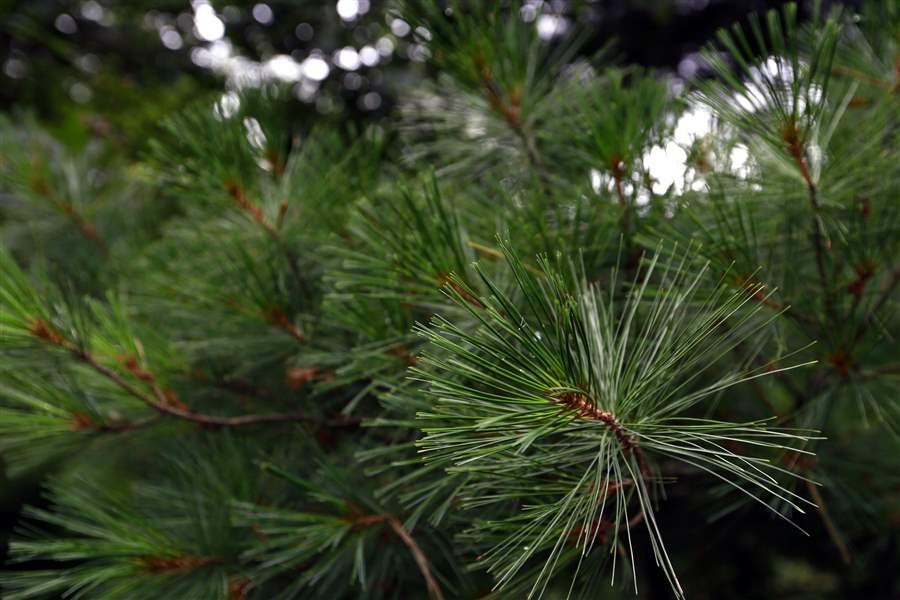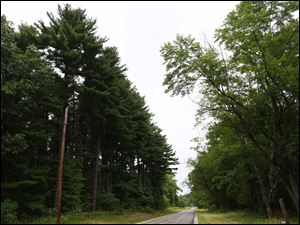
Controversial decision appearing to pay off for Oak Openings
7/20/2018
Pine trees at Oak Openings Preserve Metropark on Girdham Road.
THE BLADE/SAMANTHA MADAR
Buy This Image
The public outcry over the selective thinning of beautiful — but non-native — pine trees from Oak Opening Preserve Metropark is being tempered by science that now shows the controversial Metroparks Toledo decision from years past is paying off.

Pine trees at Oak Openings Preserve Metropark on Girdham Road.
During a lengthy presentation to the Metroparks Toledo board of commissioners on Friday morning, Scott Abella — a Toledo native and former Metroparks intern who went on to become a tree scientist at the University of Nevada Las Vegas — said plants and trees native to the globally rare Oak Openings region have taken root in soil formerly occupied by felled pine trees.
That’s just as the park district hoped would happen when it started removing pines back in 2002. Mr. Abella said the forest floors are not only being successfully converted, but that the process is happening faster than expected and - equally as important - there are not invasive plants trying to establish dominance, as has happened sometimes after tree-cutting operations in other parts of the country.
“There's no way I would have guessed the response would have been this positive,” Mr. Abella said, calling the transformation “dramatic” and “amazingly positive.”
His team’s research involves 24 monitoring plots where field data was gathered in 2002, 2004, and 2015. Mr. Abella said he also saw signs of more native plant growth just in the past three years while doing recent hikes in the area in preparation for Friday’s board meeting.
He said he was pleased to see tree frogs and butterflies using former pine stands during his recent hikes.
More than 370 native plant species have been found, including 71 wetland species and 10 state-listed species, Mr. Abella said.
Bottom line: The project is achieving its goal of enhancing the natural features of the Oak Openings, which itself holds a third of Ohio’s rarest plants. With 4,000 acres, the preserve holds more land than all of the park district’s other metroparks combined.
“We have a wealth of data,” Mr. Abella said.
The pines were planted in the 1930s and 1940s, many as part of the Civilian Conservation Corps created during then-President Franklin D. Roosevelt’s Depression-era New Deal.
At the time, Metroparks Toledo was an emerging park district. It thought about getting into the logging business as a way of underwriting its operations. The park district also planted pines to help curb soil erosion.
But the market for timber changed, and - as the pines emerged - many people grew fond of them because of their beauty. They were not managed for decades. Now, most have outlived their life expectancy. Many are dead or dying.
Metroparks Toledo decided in the early 2000s to start thinning out stands in hopes of bringing back native plants and trees.
The first tree-cutting operation was done to selective groups of pines between 2002 and 2007. More were removed in 2010, when loggers were brought in to remove debris left behind by a tornado that blew through the area on June 5 of that year, damaging not only pines but trees in general.
Tim Schetter, Metroparks Toledo natural resources director, said Oak Openings Preserve had 481 acres of pine trees. To date, the thinning has only occurred to 101 of those acres, leaving 380 acres to address.
Plans for the next round of tree-cutting will be announced this fall, as part of a 10-year plan for managing that metropark, he said.
Proceeds from those future harvests will once again be put back into restoring that region’s native prairies and oak savanna, Mr. Schetter said.
The timetable calls for bids to be taken in the fall, and the cutting to begin over the winter. The park district plans to hold a public meeting before the next round of harvesting. It cannot reasonably thin out more than 100 acres of pine stands a year, he said.
Mr. Schetter called Mr. Abella’s research a “really powerful data set to help us make management decisions” and said it “gives us confidence in moving forward.”
“We [now] know these areas respond positively,” he said.
“Doing nothing is always a choice,” Dave Zenk, Metroparks Toledo executive director, said. He said it’s clear to him now, based on Mr. Abella’s research, that doing nothing years ago would have been “one of the poorest choices.”
Contact Tom Henry at thenry@theblade.com, 419-724-6079, or via Twitter @ecowriterohio.